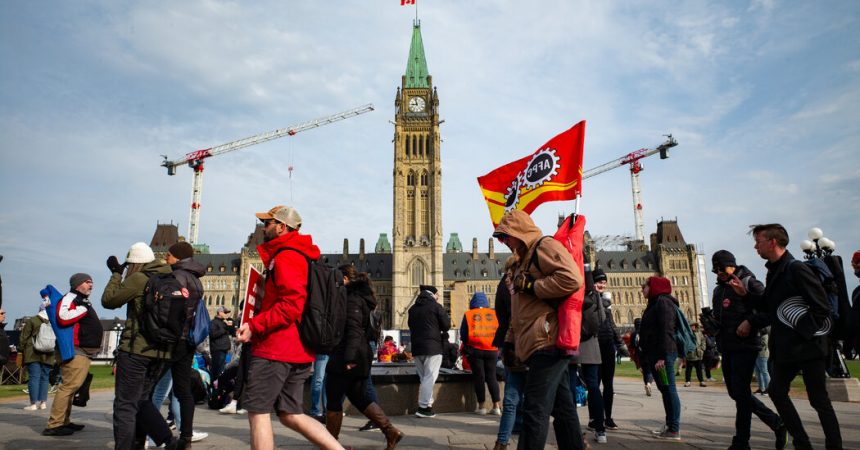This week, Chris Aylward, the national president of Canada’s largest public sector union, warned Canadians that they were facing “a summer of discontent.”
Mr. Aylward, of the Public Service Alliance of Canada, had joined with leaders from three other public sector unions to announce that they had started a series of legal challenges over the federal government’s requirement that most of their members show up at their workplaces at least three days a week beginning in September. And they said that they would take “coordinated actions” leading to disruptions as a pressure tactic.
For most Canadians, the ability to work chiefly from home faded away along with the pandemic health threat some time ago. In January, Statistics Canada reported that 20 percent of people, including government employees, spend the majority of their work time at home. That’s well down from the 40 percent level at the height of the pandemic but nevertheless higher than the 7 percent level of 2019.
Return-to-office mandates remain a major source of contention within the federal public service. It was one of the key issues behind a 15-day strike just over a year ago. But that job action did not result in an agreement giving public servants the right to mostly work from home.
Many government employees, like prison and border guards, cannot work remotely, but the government now requires that everyone else show up at the workplace at least twice a week. Mr. Aylward and the other union leaders said during their news conference that many of their members struggle to find workspaces or equipment when they arrive. They all argued that adding another day would compound those issues.
“This misguided decision sets up workers to fail by pushing them into physical offices,” Mr. Aylward said. He added that commuting more would undermine Canada’s climate goals and suggested that government offices could become residential buildings to help with the housing crisis.
Above all, the union leaders said that the decision was a political move by the Liberal government of Justin Trudeau to mollify Doug Ford, the Progressive Conservative premier of Ontario who recently said he would like to see more workers, as well as commercial landlords, back in the downtowns of cities.
One factor that did not help the government’s cause is that most public servants learned about the plan, which takes effect on Sept. 9, from a report in The Ottawa Citizen based on a leaked memo. (Executive-level public servants will be expected to appear four days a week.)
Anita Anand, the cabinet minister in charge of the Treasury Board and, thus, personnel matters, told reporters that the decision was made by senior public servants, not politicians.
Myah Tomasi, Ms. Anand’s press secretary, did not respond to questions about how that group settled on three days in the office. She did say the government verified that offices would be able to accommodate staff as they appear more frequently.
“It’s a real mess,” said Prof. Linda Duxbury of the Sprott School of Business at Carleton University, who began studying remote work long before the pandemic. “The union’s arguments are not persuasive. The union has no right to dictate. Where you work is in the hands of the employer.”
At the same time, she added, “the government of Canada is trying to do it the easy way, which is focus on days. The harder way, which is the correct way, is to focus on work.”
Professor Duxbury said private sector employers with effective return-to-work programs look at a variety of factors to determine how much workplace time is needed for each job, including “how much time is spent on client interaction, how much creativity is involved, how much innovation is required and how much time is needed for the things that we know require interaction in person.” Such reviews, she said, found that while some jobs can be done entirely remotely, others may require five-day-a-week attendance and many are somewhere in between.
The union leaders were vague about what sort of “workplace action” would set off the summer of disruption. Perhaps for good reason: Any sort of workplace slowdown or walkout would be treated by the government as illegal under labor law.
A union representing Canada Border Services Agency employees is in contract talks and could, in theory, go on a legal strike. But a government official told me that 80 percent of its members are essential workers who cannot strike.
Professor Duxbury said that if the unions make good on their threat, it’s certain to have one outcome.
“I’m not expecting a lot of sympathy from the Canadian public,” she said.
-
The federal government took a step back on a pilot drug decriminalization program in British Columbia this week, at the province’s request. After a political backlash, it is again a crime to use drugs like cocaine and fentanyl in public spaces there.
-
The arrests of three Indian men in connection with the 2023 killing in Surrey, British Columbia, of Hardeep Singh Nijjar, a Sikh nationalist, have again raised questions about the relationship between India’s external spy agency and criminal networks.
-
The actor Eugene Levy takes readers to five of his favorite places in Toronto.
-
A security guard was shot outside Drake’s Toronto mansion this week after an escalation in the rapper’s feud with Kendrick Lamar. A Chinese restaurant in Toronto has found itself caught in the middle.
-
The novelist Mona Awad presents a reader’s guide to Montreal, her hometown.
A native of Windsor, Ontario, Ian Austen was educated in Toronto, lives in Ottawa and has reported about Canada for The New York Times for two decades. Follow him on Bluesky at @ianausten.bsky.social.
How are we doing?
We’re eager to have your thoughts about this newsletter and events in Canada in general. Please send them to nytcanada@nytimes.com.
Like this email?
Forward it to your friends, and let them know they can sign up here.






